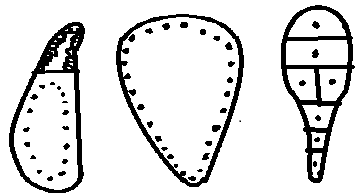
Select the correct order of endosperm types-

A. cellular, helobial, free nuclear
B. cellular, free nuclear, helobial
C. helobial, free nuclear, cellular
D. free nuclear, cellular, helobial

Answer
358.5k+ views
Hint: Endosperms are classified into three types based on how they develop. The formation of nuclear endosperm in the cell leads to the formation of a large number of free nuclei. Helobial endosperm is an intermediate type that combines nuclear and cellular endosperm.
Step by step solution:
The seeds of the majority of angiosperms contain endosperms. It provides nutrition to the developing embryo. In dicotyledons, fleshy cotyledons substitute endosperm. Endosperm stays in mature seeds of monocotyledons and stores food. Endosperm tissue comprises carbohydrates as well as proteins and lipids.
Helobial endosperm: Endosperm is a type that exists between cellular and nuclear types. The primary endosperm nucleus divides first, accompanied by transverse cytokinesis, creating two unequal cells, larger micropylar and smaller chalazal. Micropylar cells proliferate quicker than chalazal cells.
Free nuclear: The primary endosperm nucleus divides repetitively without wall formation, resulting in a significant number of free nuclei. In the meantime, inside the central cell, the central vacuole appears and pushes the cytoplasm comprising the nuclei to the periphery. The cytoplasm thickens, causing the vacuole to shrink in size. With the exception of a few cases, it eventually vanishes. The multinucleate cytoplasm cleaves and gives rise to multicellular tissue, such as maize.
Cellular endosperm: It is not widely common. The division of PEN (karyokinesis) is followed by cytokinesis, and two cells are formed as a result of transverse division, giving rise to the chalazal and micropylar chambers. Similar divisions follow, resulting in the formation of the cellular endosperm. As a result, endosperms, such as balsam and datura, become cellular from the start.
So, option C is correct.
Note: The endosperm is essential for embryonic development and serves as a food reserve. They provide nutrients as well as safety to the developing embryo. It has been demonstrated that endospermic tissues regulate gene expression and seed germination.
Step by step solution:
The seeds of the majority of angiosperms contain endosperms. It provides nutrition to the developing embryo. In dicotyledons, fleshy cotyledons substitute endosperm. Endosperm stays in mature seeds of monocotyledons and stores food. Endosperm tissue comprises carbohydrates as well as proteins and lipids.
Helobial endosperm: Endosperm is a type that exists between cellular and nuclear types. The primary endosperm nucleus divides first, accompanied by transverse cytokinesis, creating two unequal cells, larger micropylar and smaller chalazal. Micropylar cells proliferate quicker than chalazal cells.
Free nuclear: The primary endosperm nucleus divides repetitively without wall formation, resulting in a significant number of free nuclei. In the meantime, inside the central cell, the central vacuole appears and pushes the cytoplasm comprising the nuclei to the periphery. The cytoplasm thickens, causing the vacuole to shrink in size. With the exception of a few cases, it eventually vanishes. The multinucleate cytoplasm cleaves and gives rise to multicellular tissue, such as maize.
Cellular endosperm: It is not widely common. The division of PEN (karyokinesis) is followed by cytokinesis, and two cells are formed as a result of transverse division, giving rise to the chalazal and micropylar chambers. Similar divisions follow, resulting in the formation of the cellular endosperm. As a result, endosperms, such as balsam and datura, become cellular from the start.
So, option C is correct.
Note: The endosperm is essential for embryonic development and serves as a food reserve. They provide nutrients as well as safety to the developing embryo. It has been demonstrated that endospermic tissues regulate gene expression and seed germination.
Recently Updated Pages
Capping is a process in which A adenylate is added class 12 biology NEET_UG

Explain in brief the separation and isolation of DNA class 12 biology NEET_UG

Number of testicular lobules in testes is A 250 B 500 class 12 biology NEET_UG

Master Class 11 Economics: Engaging Questions & Answers for Success

Master Class 11 English: Engaging Questions & Answers for Success

Master Class 11 Social Science: Engaging Questions & Answers for Success

Trending doubts
What is BLO What is the full form of BLO class 8 social science CBSE

What is meant by exothermic and endothermic reactions class 11 chemistry CBSE

Which places in India experience sunrise first and class 9 social science CBSE

The shortest day of the year in India

What are the major means of transport Explain each class 12 social science CBSE

Which are the Top 10 Largest Countries of the World?




